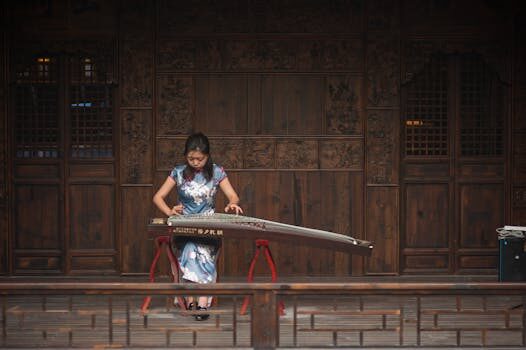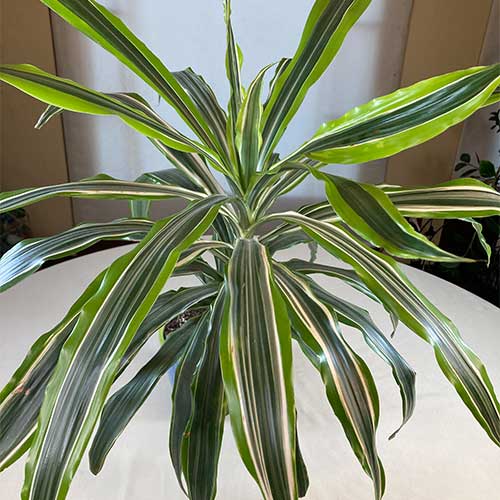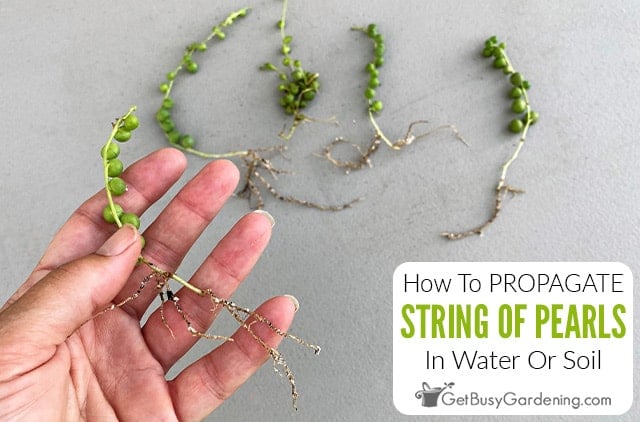If you’re a plant enthusiast, you’ve likely heard of the charming String of Pearls (Senecio rowleyanus), a succulent that’s as quirky as it is captivating. Known for its bead-like leaves that cascade gracefully over pots, it’s a favorite among indoor plant lovers. However, successful cultivation of this unique plant requires specific care and propagation techniques.
In this ultimate care guide, we’ll delve into the intricacies of the String of Pearls, including propagation methods, soil preferences, watering techniques, and how to ensure your plant thrives in its environment. Experts offer their advice on whether to propagate String of Pearls in soil or water, alongside other invaluable tips.
How to propagate string of pearls from cuttings
Propagation is a cost-effective way to expand your collection of String of Pearls. Stem cuttings are the most common method, which can root in both water and soil. Here’s how to do it:
- Cut a healthy stem of about 4 inches long with several beads on it.
- Allow the cutting to callous for a day or two to prevent rot.
- Place the cutting in moist potting soil or submerge the end in water.
- Provide bright, indirect light and consistent warmth to encourage rooting.
- Once roots appear, usually in a few weeks, plant in soil if started in water.
Patience is key as the cuttings develop roots. Whether you choose soil or water, ensure the plant receives plenty of light and avoid overwatering.
What is the best soil for string of pearls?
The right soil is crucial for the health of your String of Pearls. This succulent thrives in well-draining, light soil that mimics its natural arid habitat. A mixture of potting soil with sand or perlite should provide the drainage needed. Additionally, shallow pots can help prevent water from accumulating at the bottom, which can lead to root rot.
Regularly check the moisture level of the soil; it should feel dry to the touch before watering again. This balance will support the delicate root system of your String of Pearls and contribute to a healthy plant.
How do you know if you are underwatering or overwatering your string of pearls?
Watering is often where most succulent caretakers stumble. Overwatering is a common issue, leading to root rot, while underwatering can desiccate the plant. To strike the perfect balance:

- Monitor the soil moisture; it should be allowed to dry out between waterings.
- Look for signs of stress in the plant, such as shriveled pearls (underwatering) or yellowing and mushy beads (overwatering).
- Adapt your watering schedule according to the season, with less frequent watering in the winter.
Using a pot with drainage holes and a tray underneath can ensure any excess water has a place to go.
What are the ideal temperature and humidity for string of pearls?
String of Pearls prefer temperate climates with temperatures ranging from 70-80°F during the day and slightly cooler at night. Although they can withstand higher temperatures, prolonged exposure to heat can stress the plant.
Humidity should be moderate, as high humidity can encourage fungal growth. If you’re growing String of Pearls indoors, ensure good air circulation to keep humidity levels in check. Occasionally misting the plant can provide additional moisture without overwatering the soil.
Why do string of pearls have round leaves?
The spherical leaves of the String of Pearls are not only aesthetically pleasing but also serve a functional purpose. The round shape minimizes surface area, reducing water loss in hot, dry climates. Additionally, the pearls store water, allowing the plant to go longer periods without watering.
This succulent’s leaves are a beautiful adaptation to its environment. By understanding this, caretakers can appreciate the need for careful watering and dry conditions.
How can you prevent common problems with string of pearls?
Preventing problems with your String of Pearls involves attentive care and recognizing the signs of distress early. Here are some tips:
- Ensure adequate drainage to prevent root rot.
- Avoid direct sunlight, which can scorch the leaves.
- Watch for pests like mealybugs and treat promptly if found.
- Maintain a consistent watering schedule, adjusting for climate and season.
Regular observation will allow you to intervene quickly should any issues arise, keeping your String of Pearls healthy and thriving.
 Spider plant propagation: simple tips for getting new plants for free
Spider plant propagation: simple tips for getting new plants for free
Related Questions on String of Pearls Propagation
How long does it take for string of pearls to root in soil?
Rooting String of Pearls in soil can take several weeks to a few months. Factors such as temperature, light, and soil quality can affect the rooting time. Patience is crucial during this period, as the roots need time to develop sufficiently before they can support new growth.
Keep the soil consistently moist but not waterlogged. Observing the plant for new growth is often the first sign that roots have established.
Can you propagate string of pearls in water?
Yes, propagating String of Pearls in water is possible. Many find water propagation to be a visual and rewarding method. Simply submerge the end of a healthy cutting in water and change the water every few days to prevent stagnation.
Roots should begin to appear within a few weeks. Once a good root system has developed, the plant can be transferred to soil.
What is the best way to propagate string of pearls?
The best way to propagate String of Pearls is often up for debate among enthusiasts. Both soil and water propagation can be effective, but many experts lean towards soil propagation for a smoother transition when planting rooted cuttings. Ultimately, it may come down to personal preference and the conditions you can provide.
Why are my string of pearls leaves turning yellow?
Yellowing leaves can indicate overwatering or poor drainage. When the soil stays wet for too long, it can cause root rot, which impedes the plant’s ability to absorb nutrients, leading to yellowing leaves.
Address this issue by checking your watering routine and ensuring your pot and soil offer good drainage.

How often should I water my string of pearls?
Watering frequency for String of Pearls varies with the seasons. During the growing season, typically spring and summer, water when the top inch of soil feels dry. In the dormant season, fall and winter, reduce watering to once a month or when the soil is completely dry.
Always err on the side of underwatering rather than overwatering, as succulents are more tolerant of drought.
As we delve into the details of String of Pearls care, it’s evident that understanding the plant’s native environment is key to replicating those conditions at home. Let’s take a closer look at a resource that can further enhance your knowledge.
For a visual guide to caring for your String of Pearls, including expert tips on propagation, check out this informative video:
In conclusion, whether you decide to propagate your String of Pearls in soil or water, the real key to success lies in providing the right conditions and care. By following this guide, you’re well on your way to cultivating a thriving and beautiful succulent that can bring a touch of nature’s wonder into your home.
 Dracaena care and growing guide: how to grow a dragon tree
Dracaena care and growing guide: how to grow a dragon tree

This blog post is super insightful! I love how it breaks down the steps for propagating String of Pearls and gives such practical advice on soil and watering. It’s like a mini masterclass on making these quirky plants thrive. I never realized how much their natural environment influences their care needs. Definitely feeling inspired to give propagation a try now. Thanks for the expert tips!